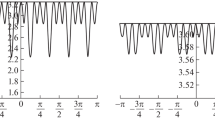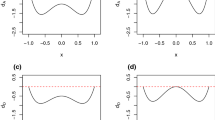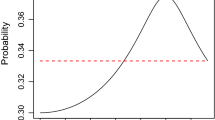Abstract
In the common Fourier regression model we determine the optimal designs for estimating the coefficients corresponding to the lower frequencies. An analytical solution is provided which is found by an alternative characterization of c-optimal designs. Several examples are provided and the performance of the D-optimal design with respect to the estimation of the lower order coefficients is investigated. The results give a complete answer to an open question which was recently raised in the literature.
Similar content being viewed by others
References
Currie A.J., Ganeshanandam S., Noiton D.A., Garrick D., Shelbourne C.J.A., Oragguzie N. (2000). Quantiative evalution of apple (Malus x domestica Borkh.) fruit shape by prinicple component analysis of Fourier descriptors. Euphytica, 111: 219–227
Dette H., Melas V.B., (2003). Optimal designs for estimating individual coefficients in Fourier regression models. The Annals of Statistics, 31, 1669–1692
Dette H., Melas V.B., Pepelysheff A. (2002). D-optimal designs for trigonometric regression models on a partial circle. Annals of the Institute of Statistical Mathematics, 54, 945–959
Dette H., Melas V.B., Pepelysheff A. (2004). Optimal designs for estimating individual coefficients – a functional approach. Journal of Statistical Planning and Inference, 118, 201–219
Eubank R. (1999). Nonparametric regression and spline smoothing (2nd ed). New York, Marcel Dekker
Hill P.D.H. (1978). A note on the equivalence of D-optimal design measures for three rival linear models. Biometrika, 65, 666–667
Jolley L.B.W. (1961). Summation of series. New York, Dover Publications Inc
Karlin S., Studden W.J. (1966). Tchebycheff systems: with applications in analysis and statistics. New York, Interscience
Kiefer J. C. (1974). General equivalence theory for optimum designs (approximate theory). The Annals of Statistics, 2, 849–879
Kitsos C.P., Titterington D.M., Torsney B. (1988). An optimal design problem in rhythmometry. Biometrics, 44, 657–671
Lau T.S., Studden W.J. (1985). Optimal designs for trigonometric and polynomial regression.The Annals of Statistics, 13, 383–394
Lestrel P.E. (1997). Fourier descriptors and their applications in biology. Cambridge, Cambridge University Press
McCool J.I. (1979). Systematic and random errors in least squares estimation for circular contours. Precision Engineering, 1, 215–220
Pukelsheim F. (1993). Optimal design of experiments. New York, Wiley
Pukelsheim F., Rieder S. (1992). Efficient rounding of approximate designs. Biometrika, 79, 763–770
Silvey S.D. (1980). Optimal design. London, Chapman and Hall
Spruill M.C. (1990). Good designs for testing the degree of a polynomial mean. Sankhya, Series B, 52, 67–74
Stroud A.H., Secrest D. (1966). Gaussian quadrature formulas. London, Prentice and Hall
Studden W.J. (1968). Optimal design on Tchebycheff points. Annals of Mathematical Statistics, 39, 1435–1447
Szegö G. (1959). Orthogonal polynomials. American Mathematical Society Colloquium Publications 23 Providence, RI
Weber W.E., Liebig H.P. (1981). Fitting response functions to observed data. Elektronische Datenverarbeitung in Medizin und Biologie, 12, 88–92
Wu H. (2002). Optimal designs for first-order trigonometric regression on a partial circle. Statistica Sinica, 12, 917–930
Young J.C., Ehrlich R. (1977). Fourier biometrics: harmonic amplitudes as multivariate shape descriptors. Systematic Zoology, 26, 336–342
Author information
Authors and Affiliations
Corresponding author
About this article
Cite this article
Dette, H., Melas, V.B. & Shpilev, P. Optimal designs for estimating the coefficients of the lower frequencies in trigonometric regression models. AISM 59, 655–673 (2007). https://doi.org/10.1007/s10463-006-0068-2
Received:
Revised:
Published:
Issue Date:
DOI: https://doi.org/10.1007/s10463-006-0068-2




